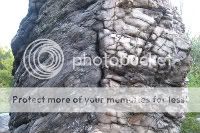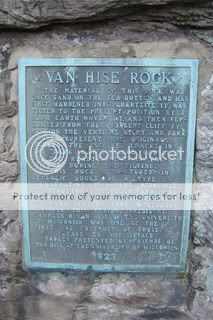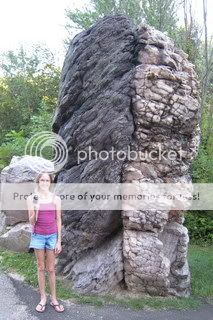This EarthCache is located just north of Rock Springs in Sauk County on Hwy 136. There is an off the highway small parking area with a paved, level path to Van Hise Rock, making this EarthCache site wheelchair accessible.
Van Hise Rock is the single most famous geological feature in the Upper Narrows Gorge of the Baraboo Range. The 700 to 800 foot hills of the Baraboo Range are remnants of an ancient mountain chain that is believed to have risen 1000 to 1600 feet above the surrounding plains. Van Hise Rock is an erosional remnant of the cliff on the other side of the highway. It is composed of two main vertical layers, one of pink quartzite* on the south side, and a darker phyllitic quartzite on the north face.

Van Hise Rock was named for the preeminent geologist of the 19th century, Charles Richard VanHise, who was also president of the University of Wisconsin-Madison from 1903-1918. VanHise used this rock to show the major structural features of metamorphic* Precambrian* rock and also to demonstrate the kinds of changes that occur in rocks through mountain building periods. Using this monolith*, Van Hise developed groundbreaking conclusions of structural metamorphic geology. Van Hise Rock and the Baraboo Range is still used regularly by universities, serving as a hands-on field laboratory for students and professional geologists.
* denotes words defined below.
A simple explanation of this rock is written on a plaque attached to the north face of Van Hise Rock which reads:
Van Hise Rock
The material of this rock was once sand on the sea bottom and has since hardened into quartzite. It was tilted to the present position by a slow earth movement and then separated from the adjacent cliff by erosion. The vertical light and dark bands represent the original layers. The inclined cracks in the dark layer were caused by the readjustment in the layers during the tilting.
This rock is pictured in geologic books as a type illustrating important principles of structural geology and has been a point of special interest to many investigators in geology visiting this region. President Charles H. Van Hise of the University of Wisconsin was one of the first and foremost of these.
Please do not deface.
Tablet presented by friends of Van Hise at the University of Wisconsin, 1923.

Definitions:
QUARTZITE, not to be confused with the mineral
quartz, is a hard metamorphic rock which was originally sandstone. Sandstone is converted into quartzite through heating and pressure.
METAMORPHIC rocks are rocks that have been substantially changed from their original igneous, sedimentary,or earlier metamorphic form. Metamorphic rocks form when rocks are subjected to high heat, high pressure, hot, mineral-rich fluids or,more commonly, some combination of these factors.
PRECAMBRIAN is a period of time, 4.5 billion to 560 million years ago. The oldest rocks on earth formed during this time, as well as the first continents, and the earliest,simplest forms of life.
A MONOLITH is a geological feature, consisting of a single massive stone or rock. Erosion usually exposes these geological formations, which are most often made of very hard and solid metamorphic or sedimentary rock.
TO RECEIVE CREDIT FOR THIS EARTHCACHE:
1. Please upload a picture of you and your group at Van Hise Rock, when you log this find. (PLEASE include all geocaching names.) If you are alone and do not have a self-timer on your camera, include a picture of your GPSr with Van Hise rock in the background. (Note: Photos are no longer required to log earthcaches, but photos are appreciated by this cache owner! Thanks for taking the time to post your pictures and preserving your own memory of your visit!)

2. What is the size (your best estimate) of Van Hise Rock?
(Height at roadside x depth x width).
3. What is the height (your best estimate) of the cliff where Van Hise rock was separated from by erosion ?
Please do not include these answers in your log.
Failure to follow these three logging requirements may result in the deletion of your log.